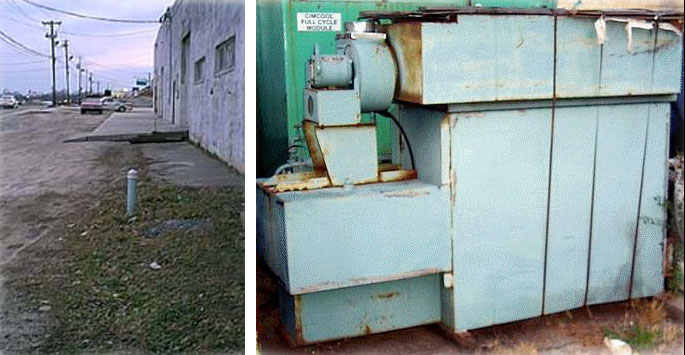Former Metal Plating Facility
Location: Woodbury Heights, New Jersey
Regulatory Program: Industrial Site Recovery Act (ISRA)
Duration: February 2000 to Present
Summary: Chlorinated Solvent Release ISRA Remedial Investigation and Remedial Action Selection, Support for Insurance Cost Recovery, LSRP Services, Remedial Funding Source
Princeton Geoscience evaluated groundwater monitoring data from nine quarterly sampling events as part of a natural attenuation monitoring program initiated by another consultant. This included developing a new conceptual model of site hydrogeologic conditions; further assessing groundwater geochemistry and potential impacts to receptors; determining site-specific contaminant degradation half-lives; application of several groundwater models (BIOCHLOR, Disperse and site-specific calculations); and development of a proposed Classification Exception Area (CEA) and monitoring program.
In addition, we worked with a New Jersey certified mobile laboratory contractor to rapidly identify and thoroughly delineate the extent of soil causing groundwater impact adjacent to the former location of a vapor degreasing unit. This assessment was conducted in an adaptive manner consistent with EPA’s Triad method. This concentrated effort provided a high resolution look at source conditions needed for remedial planning, while avoiding the repeat mobilizations and added cost typical of traditional source investigations.
Based on results of these activities, Princeton Geoscience determined that some initial treatment of soil and groundwater at the source area is necessary, prior to transitioning to monitored natural attenuation. A remedial program has been developed which includes a focused application of enhanced, in-situ bioremediation. Following completion of benchscale treatability testing, an electron donor source will be injected into the subsurface at the former release area, to enhance the reductive dehalogenation processes currently taking place. A groundwater monitoring program will be performed to evaluate the effectiveness of the remedy and determine when benchmarks for switching to monitored natural attenuation have been achieved.
An important aspect of this project has been completing activities required under New Jersey’s Industrial Site Recovery Act, initially wholly within the limited financial constraints of the former property owners responsible for the cleanup. Princeton Geoscience was initially informed by the client and their attorney that attempts to recover costs through the client’s former insurer had determined that no financial relief was possible, because the insurance company was no longer in business. For this reason, the client (a retired individual) had been paying project costs personally since the mid-1990s. Princeton Geoscience discussed the case with several attorneys and identified a firm willing to pursue insurance reimbursement on a contingency basis. Working with Princeton Geoscience, the firm obtained proof of past insurance coverage. The successor to the client’s insurance company subsequently acknowledged the coverage and agreed to pay an allocated share of past and future costs associated with the groundwater remediation project.
Following New Jersey’s adoption of the Site Remediation Reform Act (SRRA), the client decided to “opt in” to the program, retaining Princeton Geoscience as the Licensed Site Remediation Professional (LSRP) of record. Activities Princeton Geoscience recently completed include Vapor Intrusion (VI) investigations onsite and on several offsite properties; design, installation and commissioning of an onsite vapor mitigation system; completion of an updated Receptor Evaluation; and development of a remediation cost estimate to support annual LSRP certification of a Remedial Funding Source (RFS).
An existing remediation trust fund is at present significantly underfunded relative to the projected remediation cost, and the client has indicated he is unable to fund his full share of the amount required to establish a fully funded RFS. Princeton Geoscience initiated discussions between the client, their insurer and the Supervisor of NJDEP’s Remediation Funding Source Unit to seek resolution of the matter in a way that will allow progress to continue. As a result, scenarios for settlement between the client, insurer and NJDEP have been discussed and negotiations are in currently in progress.
